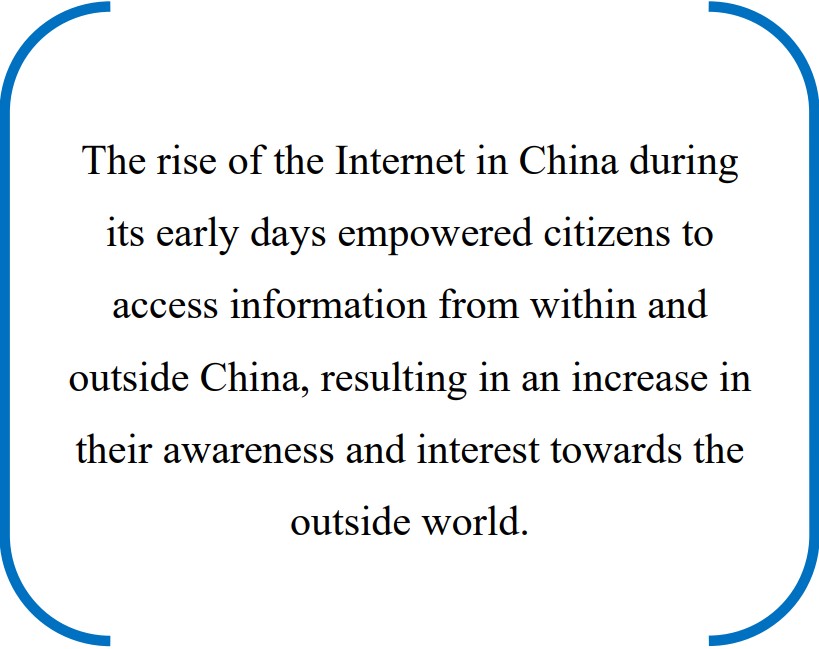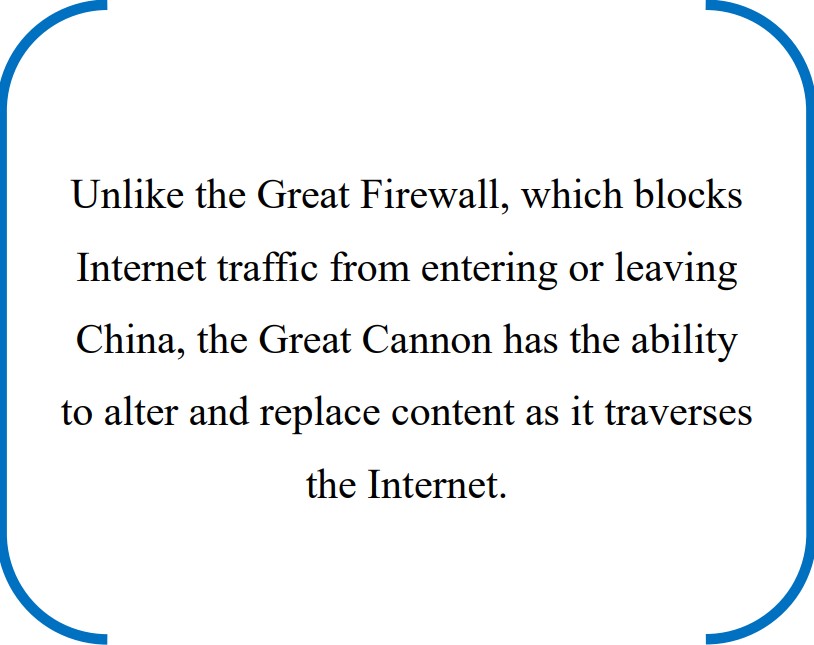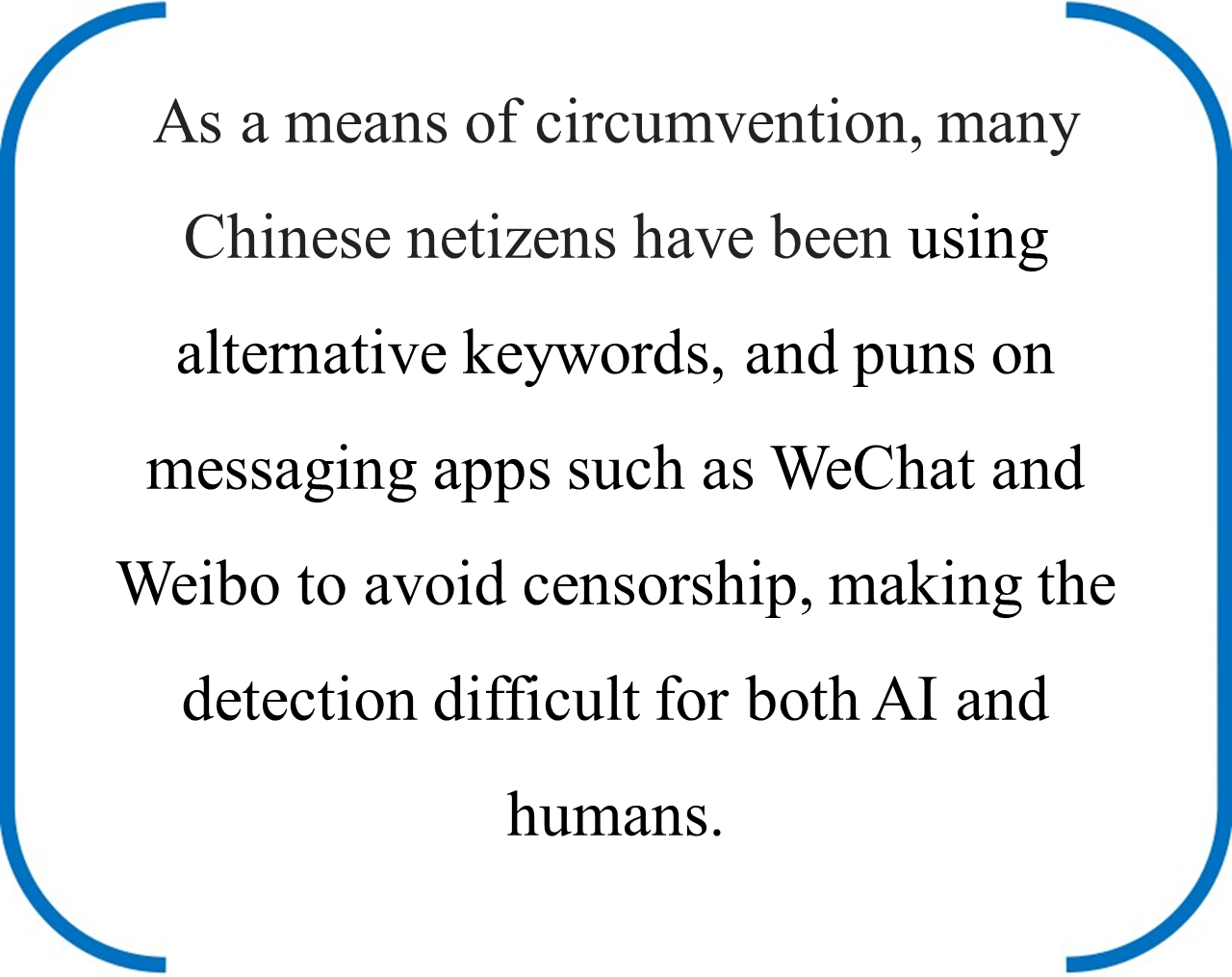-Ankit Kumar, MA Student, MA in Chinese Language and Culture Studies, Centre for Chinese and South East Asian Studies, Jawaharlal Nehru University, New Delhi
Introduction
On 14 September 1987, the very first recorded email stating, “across the Great Wall, we can reach every part of the earth” was sent from China to Germany with much optimism. Subsequently, in 1994, the Internet was made available for public use in China.
The Chinese government first encouraged internet growth for business, entertainment, education, and information sharing, but it was closely monitored to prevent dissent, and the spread of Western ideas. Consequently, the Golden Shield Project came into existence in 1996. The Golden Shield was first termed as the Great Firewall (GFW) of China by Sang Ye and Geremie Barme in 1997 in an article for the Wired magazine. It can be understood as a highly complex and sophisticated system for filtering and monitoring online content. Apart from allowing the Chinese government to monitor the inflow and outflow of information via the Internet, restrictions set in place also paved the way for significant censorship.
Internet censorship in China is ever-evolving as it adjusts according to real-time situations. Chinese netizens and scientists are finding it increasingly difficult to access information from external sources owing to the restrictions on various globally used social media sites such as Twitter, Facebook, and Whatsapp, among others, as well as search engines such as Google. Moreover, the scale of Internet censorship has only increased in intensity under President Xi Jinping. The recent Chinese government regulation requiring mobile apps operating in China to submit their business details to the government, is a prime example of how the government is effectuating rigid control, especially over the tech sector.
Background of Censorship in China
The practice of censorship in China has a long history. The invention of printing under the Tang dynasty (618-907 C.E.) laid the foundations for publishing. It flourished under the Song dynasty (960–1279 C.E.) owing to the advent of movable type printing technology in the 1040s C.E. for printing books. Song rulers responded to the significant increase in publications by formulating laws and regulations to control the production and dissemination of books and literature. This development set the foundation of censorship in China, with subsequent dynasties following a similar pattern of deliberate and direct censorship.
The rise of the Internet in China during its early days empowered citizens to access information from within and outside of China, resulting in an increase in their awareness and interest towards the outside world. The Chinese leadership also recognised the power of the Internet towards understanding public concerns and shaping public opinion as the Chinese people explored its potential.

The ever-growing accessibility of the Internet also facilitated the emergence of various groups which played a vital role in disseminating politically sensitive information and establishing discussion forums for underground organisations. As a result, the government became increasingly worried about the potential for large-scale organised political dissent, which could pose a threat to the government. For instance, during the late 1990s, the Falun Gong (a spiritual group founded by Li Hongzhi in China in the early 1990s, and labelled as an “evil cult” by the Chinese government) became the first spiritual group to spread its reach within and outside of China using the Internet. In 1999, the Falun Gong held a demonstration in Beijing to protest against the control and authority of the Chinese government. Following this highly organised demonstration, the Communist Party of China (C.P.C.) took severe measures against the members of the Falun Gong Movement, whose membership and activities had grown through email and mobile communication, facilitated by access to the Internet.
In recent years, various restrictions have been imposed upon the cyberspace in China. This has been facilitated by governmental actions such as ensuring that the Chinese public commits to a form of self-censorship under the Public Pledge of Self-Regulation and Professional Ethics for China’s Internet Industry, issued by the Internet Society of China. Every major Internet-based company such as Alibaba, Tencent, Baidu, and Sohu, and even universities such as Peking University and Tsinghua University in China have “voluntarily” signed this pledge and implemented self-censorship by proactively restricting information that is deemed undesirable.
Why China Censors Its Citizens
China implements Internet censorship primarily to maintain stability by preventing the dissemination of information that could incite social unrest or organised political dissent towards the government. This control over the flow of information allows the government to curtail dissent and maintain effective control over the population. Additionally, censorship enables the government to control the narrative surrounding sensitive political issues like protests, democracy, social inequality and political criticism. This, in turn, allows the Chinese government to ensure that only information aligned with its official stance is accessible to the public. Elizabeth C. Economy, Senior Fellow at the Council on Foreign Relations, says:
“The Chinese government is in a state of “schizophrenia” about media policy as it goes back and forth, testing the line, knowing they need press freedom and the information it provides, but worried about opening the door to the type of freedoms that could lead to the regime’s downfall.”
A study conducted by Harvard University researchers in 2013 found that the Chinese leadership has allowed social media to thrive in the country, allowing people to express diverse opinions about the government and its leaders, as long as the discussions of events with potential for collective action are effectively curtailed. This implies that while individuals in China are free to express themselves individually, to an extent, they remain collectively constrained in terms of expression. Another study conducted in Beijing by researchers Yuyu Chen and David Y. Yang in 2019 found that students who were randomly equipped with the tools to bypass Chinese censorship were 42.4% more likely to be aware of the Hong Kong protests and 13.7% more likely to be aware of the 2011 Arab Spring protests. The researchers’ analysis suggests that censorship in China restricts access to sensitive information and suppresses citizens’ demand for it. Nonetheless, the surveyed students displayed notable changes in their knowledge, beliefs, attitudes, and conduct after accessing foreign news outlets. The same study also discovered that 64% of students accessing uncensored internet are more likely to indicate their interest in pursuing higher studies at foreign universities. Additionally, they also developed a negative perception of the Chinese economy and model of governance.
How China Censors the Internet
Over the span of the last thirty years, China has constructed a complex network of sophisticated surveillance systems. The Golden Shield Project, also called the National Public Security Work Informational Project, remained operational until 2008, before being replaced by the Golden Shield Phase II Project. The new system incorporates advanced technologies and methods, such as artificial intelligence and big data analytics, to improve the government’s ability to monitor and censor online content.
Furthermore, in 2015, Beijing introduced a new instrument known as the Great Cannon. Unlike the Great Firewall, which blocks Internet traffic from entering or leaving China, the Great Cannon has the ability to alter and replace content as it traverses the Internet. In addition, the Chinese government is known to employ various techniques such as D.N.S. filtering, I.P. blocking, U.R.L. filtering, keyword blockage, and packet filtering, which is directed at curtailing the Chinese public from browsing and accessing content deemed undesirable by the C.P.C. In a paper titled How Great is the Great Firewall? Measuring China’s DNS Censorship, researchers used GFWatch, a platform which tracks the Great Firewall, for their study. They stated that upon testing 534 million different domains, approximately 311,000 domains have been blocked in China.

The government also requires all internet service providers and website owners to register with authorities and comply with strict regulations on content and user data. Chinese Social media platforms such as WeChat and Douyin are subjected to extensive monitoring and censorship as well. Chinese Internet censors consist of human moderators supported by artificial intelligence, which enables them to effectively censor the Internet experience of the Chinese population. According to various reports, as of 2013, China has employed over two million moderators to police the Internet.
Censorship Under Xi Jinping
In the years since Xi Jinping rose to power, Internet censorship has become stricter with the changing political landscape of China. In 2016, President Xi officially announced that “all the work by the party’s media must reflect the party’s will, safeguard the party’s authority, and safeguard the party’s unity,”. Since then, the Party has dictated the course of Internet censorship in China, moving beyond Party media, to other media houses as well.
In 2015, President Xi ordered a heavy crackdown on virtual private networks (VPNs), which severely limit their usage within China’s online boundaries, and also restrict the sharing of information with the outer world. A Chinese biologist expressed dissatisfaction with Internet censorship restricting research in China in an essay titled, ‘Why Do Scientists Need Google?’ in 2015. He wrote:
“If a country wants to make this many scientists take out time from the short duration of their professional lives to research technology for climbing over the Great Firewall and to install and to continually upgrade every kind of software for routers, computers, tablets and mobile devices, no matter that this behaviour wastes a great amount of time; it is all completely ridiculous.”
As can be seen, Internet restrictions in China have even hampered the pursuit of science.
Last year, the Urumqi fire triggered widespread public anger, quickly spreading through social media despite China’s strict Internet controls. Although sharing restricted information or criticising the authorities often results in censorship and harassment, Chinese platforms initially struggled to handle the large volume of videos and messages related to the incident, similar to the public reaction to Dr Li Wenliang’s death during the early days of the COVID-19 pandemic. Chinese users creatively evaded censorship using hashtags like “A4” and “white paper exercise” on Weibo, symbolizing the government’s constraints on free speech. They also used VPNs, to as great an extent as possible, to access and share uncensored content as the protests progressed. However, Chinese authorities responded by implementing a stringent form of censorship referred to as Level I Internet Emergency Response, in order to restrict the dissemination of content beyond the country’s borders. These directives, issued by China’s cyberspace administration, represent the highest level of content management in China.
How Chinese Netizens Respond to the Censorship
In the early 2000s, the Internet was used by influential bloggers and social media figures who lobbied for reforms, organised rallies, and exposed corruption. The term Human Flesh search engine (人肉搜索引擎 renrou sousuo yinqing) was popularised during this time, in which Chinese netizens rallied to conduct investigations and hold people accountable.
Recently, many Chinese citizens have developed ingenious tactics to circumvent censorship on social media platforms. According to data collected by the citizen lab, more than 9,054 keywords such as “May 35” (or its Chinese version 五月三十五, related to the Tiananmen Protests), “disagree” (不同意), “personality cult” (个人崇拜), “my emperor” (吾皇), “animal farm” (动物庄园), among others, are banned in China. As a means of circumvention, many Chinese netizens have been using alternative keywords, and puns on messaging apps such as WeChat and Weibo to avoid censorship, making the detection difficult for both AI and humans. For example, the keyword “Henan” (河南) was replaced with “Helan” (荷兰), while protesting against the Henan bank scandal. Similarly, the keyword “mitu” was used while discussing the #MeToo scandal in China.

Chinese citizens, in huge numbers, had started to question the handling of the COVID-19 crisis by the local governments. This criticism was met with online censorship by the authorities. Initially, Weibo users discovered that the local authorities shadow-banned any posts containing the word 武汉 (Wuhan) or 湖北 (Hubei), in order to censor any criticism. In response, Chinese Netizens swiftly resorted to using “wh” and “hb” as substitutes for Wuhan and Hubei, respectively, to post their grievances. These substitute keywords represent the pinyin initials of both regions and are readily understood by other users.
Similarly, during the “white paper revolution” many protesters used the Friedmann Equation, along with blank white paper, to demonstrate against the stringent COVID prevention measures. This equation was used for two reasons. First, Friedmann’s phonetic sound is similar to the English word “Freedom”. Second, the Friedmann Equation denotes the expansion and change in the universe. By using this equation, they aimed to advocate for a change in the present system of control, and seek freedom from the strict COVID prevention protocol.
Conclusion
Deng Xiaoping famously said, “if you open the window for fresh air, you have to expect some flies to blow in”. When China entered its Reform Era, enacting the opening-up policy in 1978, it tried to achieve a balance between “opening up” to the Western world in terms of trade and economics, and shielding its citizens from Western ideas. However, as trade and investment between China and the world increased over time, not only did Western goods start flowing in, but ideas that were uncomfortable, or undesirable in the eyes of the C.P.C. also started entering China. Chinese authorities, since then, have been continuously engaged in swatting these “flies”. This can be seen more prominently after Xi Jinping assumed office in 2013. Since then, he has passed many strict laws and regulations such as the National Security Law (2015), Online Publishing Service Management Rules (2016), Cybersecurity Law (2016), and Data Protection Law ( 2021), among others.
During the COVID-19 pandemic, the Chinese government rapidly censored many posts on social media, as exemplified during Fang Fang’s Wuhan Diary incident. Due to the high level of censorship, many Chinese citizens could not even post SOS messages on social media. Furthermore, Chinese authorities have begun to scrutinize finances and implement anti-monopoly measures against technology companies, signalling a collective effort in fortifying the censorship system and restricting online mobilization. However, Chinese netizens have developed their own methods and techniques, which include employing puns, and alternative keywords, among others, to counter the measures taken by the C.P.C. As noted, even a scientific equation was employed as a symbolic method of protesting against government policies.
Censorship in China has had a historical existence in China, however, the manner in which it has taken centre stage in the C.P.C.’s efforts to control the Chinese public in recent years is of great importance. As has been discussed above, censorship has been implemented in various ways, employing a plethora of methods, including laws and regulations, bolstered by technological advancements. At the same time, the resolve of the Chinese people to circumvent the established rules and norms in order to express themselves is commendable.